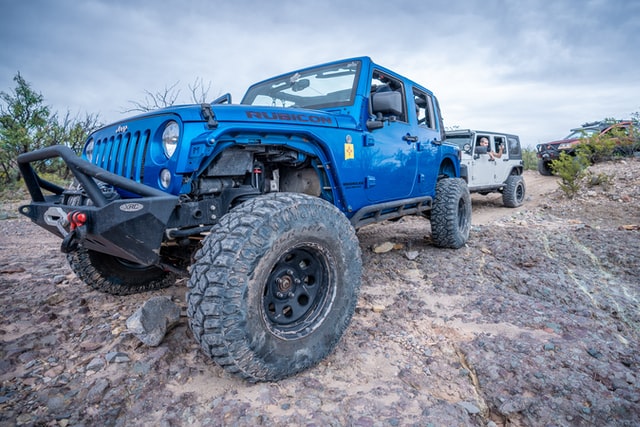How to Bleed a Hydraulic Clutch on a Jeep Wrangler

I’ve just returned from picking up my Jeep at the dealership. They used a new part number clutch to replace the throw out bearing and the clutch. The squeal has vanished, as has the squeak. It doesn’t feel like that in my clutch. I used to be able to engage the clutch by simply pushing it in an inch or two. I’m going to have to push it almost all the way to the ground now. I’m curious as to how the hydraulic clutch component is bled. It feels like a terrible brake job if I were to explain it. The service book suggests to bleed the system, but it doesn’t indicate how to do that. Is it possible to get some assistance?
The following is taken from the text:
1. Install the slave cylinder (3) in the transmission first.
2. Connect the slave cylinder to the hydraulic line (2) with a bracket. Check that the O-ring on the hydraulic line is in place.
3. Tighten the slave cylinder nuts to 23 Nm (17 ft. lbs.).
4. Ensure that the hydraulic system is completely bled.
Only one “port” on my slave cylinder has a screw, but it’s a hex head plug style screw. I don’t have a zerk fitting to attach a vacuum pump to, so I’m out of luck. I went to get a new slave cylinder today, and it didn’t come with anything in that port, but the AutoZone employees told me that I could just replace it with my current slave cylinder. According to my Haynes manual, I should remove the dust cap that covers the bleeder screw, but I have no idea where that is located.
It’s bled in the same way that brakes are bled.
• Unscrew the bleeder valve, press the clutch to the floor, and keep it there until no more air comes out.
• Check the fluid level in the reservoir after each cycle.
• Try rapidly pumping the clutch to see if you can build up pressure; if there is air or fluid in the lines, you should get something. There’s a leak someplace if you don’t do it.
Clutch Bleeding
Getting a friend to assist is the simplest method. the cap from the master cylinder and fill it with brake fluid, then replace the cap. Allow a friend to push the clutch a few times before lowering the pedal to the floor. If you’re using a bleeder on the slave cylinder at the bell housing, loosen it slowly to allow air and fluid to escape. Check fluid level and top off, if necessary, after retightening bleeder. Allow your companion to reactivate the clutch pedal and repeat the process. repeat until your clutch is firm once more. If this does not remove all of the air, call me and I will tell you how to do it in a more advanced manner.
It was now a hydraulic problem; when I pressed the clutch pedal, there were no more frightening mechanical noises from the transmission. I ended up driving it the 200-odd miles back to Utah without a working clutch (which is a skill in and of itself). Because of the design and arrangement of the hydraulic line, one of my Jeep technicians claimed that bleeding the TJ clutch system is practically difficult. The physical procedure is straightforward (similar to bleeding brakes); however, the twists and curves in the lines are notorious for trapping air during the bleed. This is the main reason why Chrysler does not offer individual master or slave cylinders for the TJ clutch; instead, they only provide a whole hydraulic assembly that includes both cylinders, the lines connecting them, and fluid that is ready to use.
Procedures to Follow
Check the brake master cylinder’s fluid level and top it off if needed. Run a transparent hose from the faucet to a suitable container to divert the fluid. Close the bleeder and depress the clutch pedal.
1. On the slave cylinder
2. allowing the fluid to bleed out before closing it.
3. Rep this process until the bleeder is clear of air.
4. Replace the dust cap on the bleeder and install the slave cylinder on the transmission after removing the drain hose.
5. Press down on the clutch pedal 25 times, then start the engine to check clutch operation and pedal sensation. If the clutch does not entirely disengage or the pedal feels spongy, air is still trapped in the hydraulic circuit and must be bled again.
A hydraulic clutch to be bled?
Although most hydraulic clutch systems have their own master cylinder, certain cars combine the brake and clutch systems into one master cylinder. You’ll need to bleed the hydraulic system every time you open it to get rid of any trapped air.
How do you bleed a jeep hydraulic clutch?
• The front of the vehicle should be jackknifed.
• The hood should be opened.
• Remove the clutch fluid reservoir’s cap
• The pressure bleeder should be screwed onto the reservoir’s top.
• Several times pump the clutch.
• If you’re using a power bleeder, keep an eye on the gauge and set it to around 12 PSI.
How do you bleed a hydraulic clutch without a bleeder valve?
- For slave cylinders without bleed screws, the following is the proper bleeding procedure: Allow the slave cylinder pushrod to fully extend by pushing it inward and disconnecting both bands of the retaining strap.
- Set the slave cylinder to a 45-degree angle.
- To use the slave cylinder port, connect the master cylinder line to it.
Where is jeep wrangler clutch fluid reservoir location
On the driver’s side, it’s close to the front of the transmission. Fill the brake fluid reservoir with DOT 3 brake fluid until it’s completely full. From the bleed screw, remove the rubber dust cap.
